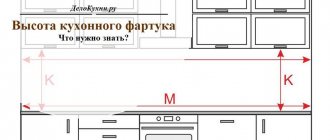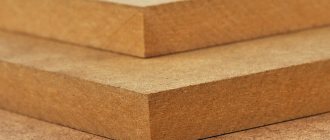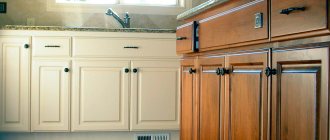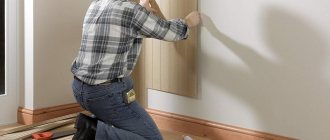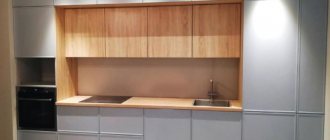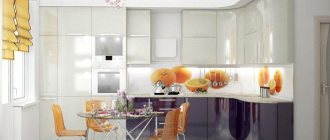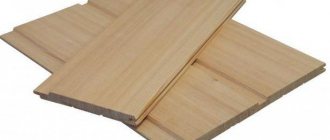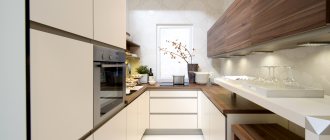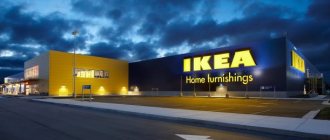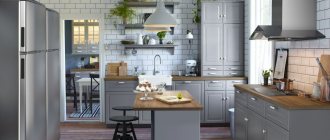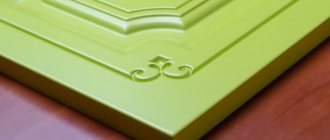Medium Density Fiberboard (MDF) began to be produced on an industrial basis in the USA in 1966; in our country, the technology appeared only in 1997, the boards were called MDF. The name stands for medium density fibreboard.
What is MDF in furniture
At the experimental level, the American William Mason tried to create the first slabs in 1924; he found a way to process waste from the woodworking industry, separated them into individual fibers with a Mason gun and sent them for pressing.
Manufacturing technology
Medium density fiberboards (MDF) are produced from natural wood, depending on the company's reputation, the amount of waste is up to 20%, the rest is industrial wood. In this case, the volume of coniferous species cannot be lower than 70%. Production is carried out using the following technology.
- Grinding. All raw materials are fed into powerful crushers; while the rotor rotates, they are cut and crushed. The output should be wood chips. Subsequently, the raw materials are sent by a belt conveyor to drums for mixing with purchased wood chips.
- Preparing wood chips. It is sifted on sieves to remove fine wood dust, the purified product is supplied for washing (dirt and soil are removed) and cooking. The process takes place in large sealed boilers with superheated steam. Steam pressure is 10 bar, due to high parameters, decomposition is significantly accelerated, the amount of insufficiently processed wood chips is reduced.
- Grinding in a refiner. This unit splits wood chips into a fibrous state; the length varies and depends on the size of the wood chips and the characteristics of the technological process. The properties of the board depend on the length of the fibers; separate standards exist for MDF and HDF boards.
- Blow with dry air and mix with glue. The components are uniformly mixed, and the finished mixture is blown into a long pipe for final drying. The raw material should have a moisture content of 12–15% at the output.
- Separation of fibers from air. For this purpose, cyclones of a centrifugal operating principle are used. Heavy ingredients hit the walls and settle, clean air comes out into a special hole.
- Purification of the mixture. The raw materials should be cleaned of lumps of glue and large solid impurities; their quantity depends on the quality of the raw materials.
- Pre-pressing. The fibers are first fed to the spreading line, the height is leveled, and pre-pressed on a cold press. It is at this stage that the thickness of the MDF boards is established. During cold pressing, the final removal of air occurs; this parameter has a great influence on quality. At the exit from this press, the edges are cut and the specified parameters are controlled.
- Final pressing. The tape is sent to the main press, the process takes place at a temperature of +240°C and under high pressure. With the help of special profiles, the appearance acquires the intended structure.
Pressing
Plate after pressing
Trimming ends
Applying a decorative layer
Preparing for packaging
Packaged MDF products
*Click on image to enlarge.
Next, the products are cut, weighed and fed to a cooling drum to lower the temperature. The slabs are stored for temporary storage for 2–3 days, during which time the adhesive composition gains maximum strength. At the exit, another quality control is done.
At the final processing stage, the surface of the slabs is ground and cut to specified dimensions. Depending on the purpose of the boards and the requirements for their performance characteristics, they can be sold in sanded form or polyethylene film and veneer are applied to the surface.
Video - Production of MDF and HDF boards
Important. As can be seen from the description of the technological process, MDF boards cannot be classified as environmentally friendly products.
Production involves the use of adhesives based on artificial resins, rather than the mythical natural gluten from wood. During the manufacturing process, special fillers and ingredients can be added, due to which they are given wear resistance, biostability and water resistance. Additives affect the cost; they are on average 1.3 times higher than the price of chipboard. But due to the fairly high strength, it is possible to reduce the thickness of the slabs; in this parameter they exceed chipboard by about 1.8 times.
Chipboard or MDF: what are the differences and which is better
From time to time the question arises: what is better than MDF or laminated chipboard and what differences exist between them.
Laminated particle board, as well as MDF panels, are made from sawdust by pressing them under pressure with the addition of special adhesive mixtures.
Laminated MDF panels Source abvmaster.ru
This is where their similarities end. MDF boards have their own differences and advantages, which is why they have become more popular in the manufacture of furniture and interior decoration of residential and commercial premises.
The main advantage of the panels is the ability to firmly hold screwed elements. In this indicator, this material is superior to laminated chipboard. This point is especially important in the manufacture of furniture, since the doors of kitchen cabinets, shelves, and door handles must be attached firmly and reliably. It is almost impossible to re-screw a screw or other fastening element into a chipboard, since the holes become very loose. MDF panels with higher density hold screwed elements more firmly and reliably.
The second factor in favor of MDF is the environmental friendliness of the material. Chipboard contains formaldehyde resins, which are unsafe for human health, especially for the respiratory tract. Therefore, it is not advisable to use this material for children's and kitchen furniture.
Laminated chipboard is inferior to MDF in terms of moisture resistance. Therefore, it is not entirely suitable for furniture in the bathroom and kitchen. Although in general the plate is well protected from mechanical damage.
Kitchen interior using MDF Source sanmari.by
Types of MDF
The thickness of the slabs ranges from a few millimeters to more than a centimeter, the length and width depend on the technical parameters of the production lines and existing industry standards. Taking into account the finishing of external surfaces, there are several types.
| Slab type | Brief technical specifications |
| During production, great quality is given to only one side, then it is covered with a special PVC film with different color shades and patterns. If previously imitation of natural wood was most often used, now photographs, including those using 3D technology, are very popular. The film is not afraid of moisture, has relatively high mechanical resistance parameters, and is made from modified raw materials with additives that increase resistance to hard ultraviolet rays. The surface can be easily washed with both conventional and acid-containing detergents. |
| More expensive panels have natural wood veneer glued to the outer surfaces. The thickness of the veneer depends on the purpose and grade of MDF. To protect external surfaces, veneer can be treated with especially durable varnishes. |
| Most often used in the furniture industry, their cost falls into the budget category. One side of the slab is smooth, which improves its appearance and allows it to be used without additional layers of topcoat. The glossy surface is impregnated with chemicals that increase the moisture resistance of the slab. |
When choosing, you need to choose a slab whose physical characteristics best meet the actual operating conditions.
How to install MDF panels on the floor and ceiling
It is quite easy to install the panels on the ceiling, the main thing is that the surface does not crumble. In their work they use a pencil, a level, a tape measure, a ruler, a hammer drill, a screwdriver, and metal scissors. You need to purchase profiles, screws and hanging parts, the panels themselves, skirting boards, plugs, connectors.
- Assemble the frame using a level and making marks around the perimeter. The distance from the ceiling should be approximately 5 cm.
- Check for hidden wiring with a special device.
- The starting profile is fastened with dowels or self-tapping screws with a fastening pitch of 400 mm.
- Install the ceiling profile, placing it in the starting profile in increments of 400-600 mm. Attach the ceiling profile to direct hangers using self-tapping screws.
- The panels are fastened using tongue-and-groove technology. The first plate is fastened with self-tapping screws. The fastening pitch is about 200 mm. The next tile is inserted into the groove of the previous one and secured with clamps.
Work is progressing quite quickly
Using MDF
The main consumer of slabs is the furniture industry; they are often used for finishing interior spaces for various purposes.
Decorative wall panels
Laminate is made on the basis of MDF, furniture facades are finished with decorative threaded elements.
Furniture facades made of MDF
Another feature of the slabs is that during milling they emit dust, which makes them an excellent material for milling shapes of complex geometry.
3D CNC milling of MDF
Artistic milling of MDF
Production
Wood shavings of fine dispersion go through two main processes, just like all boards based on wood waste: high temperature conditions and repeated pressing. The production process is in many ways similar to the production of chipboard. Small, cleaned chips are thermally treated.
Their gluing is achieved using the natural substance lingin. Most manufacturers modestly point out that there is still a certain amount of impurities present in MDF, but its percentage is negligible to make this material environmentally hazardous.
As for the labor intensity of production, it is as low as possible in factories with modern equipment. For this indicator, MDF production receives the first rating of 5 points.
Specifications
The classification, definitions and accepted symbols of MDF boards are prescribed in GOST 34026-2016.
Wood fiber boards. Definition, classification and symbols.
Depending on the production technology, wood fiber types can be of two types.
- Wet production method. The most famous among builders and furniture manufacturers, they are distinguished by increased performance characteristics. A detailed description of the technological process is given in this article a little higher.
- Dry production method. By simplifying the technology, the cost is somewhat reduced; synthetic materials containing harmful compounds are used as adhesives. Not recommended for use in residential premises. Foreign inclusions are noticeable on external surfaces, which reduces quality.
Depending on the parameters of physical and mechanical strength, MDF is divided into grades, the grade of each of them is influenced by the quality of the surface. The pressing process can be continuous or batch. In the first case, the material is fed to the line by a continuous belt, cutting to size is performed at the finishing stage. In the second case, prepared raw materials are poured into special molds, and after leveling, the press piston performs reciprocating movements.
Cutting and cutting MDF
It is best to buy products that have standard sizes and are factory processed. If there is a need to cut MDF, it is worth entrusting this to specialized workshops. As a rule, in large cities using such a service is not a problem.
Cutting to individual sizes should only be done using special format-cutting equipment.
MDF cutting experts know that the workpieces need to be placed on the machine with the back side up. When putting saws into operation, the movement of the plates should be progressive and as smooth as possible. The immersion of the teeth into the plate should be only 1 millimeter. The passage of the row should signal that the saws can now be immersed again and again by 1 millimeter.
Proper cutting will help you get new parts to the right size. This process is quite labor-intensive, but it makes it possible to obtain the necessary blanks for the manufacture of doors and furniture outside of factory conditions.
MDF production today is modern and highly improved. The use of natural materials indicates that this product is environmentally friendly. And the process of using it is not labor-intensive.
Classification of slabs according to the characteristics of the front layer
This is a very important parameter of products; consumers choose products for themselves taking into account their specific purpose and operating characteristics. The front surface can be of several types.
- The surface is untreated. The cheapest slabs are recommended for use as secondary or temporary structures. Additionally, the layer can be tinted. The low cost fully corresponds to the same quality.
- There is a finely dispersed mass on the front layer. Due to this, large irregularities are eliminated. The surface can be painted or left in its natural state.
- With increased water resistance. Surfaces can be ordinary or with a finely dispersed layer.
Untreated surface
MDF panels for walls
*Click on image to enlarge.
MDF SPA panels
Conclusions and recommendations
Furniture or interior decoration made from MDF is quite an attractive, albeit expensive, option for furnishing a house or apartment. The material is durable, which guarantees the preservation of its qualities over a long period of operation. Especially if the room is dry and bright.
When making furniture for the bathroom and kitchen, an important advantage of MDF is the moisture resistance of the boards. This allows bedside tables and cabinets to maintain excellent presentation in the aggressive conditions of these rooms, such as increased dampness and temperature changes.
Working with MDF panels is not difficult Source ingushetia.org
Safety classification
We have already mentioned that there are no MDF boards that are completely safe for health; during their production, synthetic urea-formaldehyde resins are used in quantities of up to 120 kg/m3 and a hardener of up to 5 kg per cubic meter. All of them release formaldehyde into the air. Each country has its own requirements for the amount of harmful compounds; the permissible parameters are often influenced by the industrial lobby. We have three classes of formaldehyde emission: E0.5, E1, E2. The first ones are the safest, the third ones are prohibited for use in residential premises. But you need to know that physical strength is inversely proportional to the safety class. The more glue, the stronger the board, but the more formaldehyde is released.
Advantages and classification of MDF
Idea of a façade slab
MDF construction consists of a board made from medium-density wood fiber. It is considered an environmentally friendly material due to the fact that the manufacturing process does not contain the addition of chemical binders to the product. The role of a binding impurity is played by the natural component lignin, which is a component of wood.
The material is pressed from dry fine particle fiber under the influence of high temperatures and pressure. As a result of this, the wood releases a lignin substance that binds all components. The production process involves imparting special properties to the product: water resistance, biostability and low flammability.
Initially, MDF began to be manufactured in 1966 in the United States. China is currently the leading country in the production of material on the world market.
Taking into account operational criteria, facades are divided into certain types of slabs, which consist of:
- From slabs intended for storage in dry rooms.
- Made from wood materials that are resistant to moisture.
- From slabs used for the manufacture of furniture with a high load of structural elements used in a normal room.
- Made from heavy slabs used in damp conditions.
Classification according to acceptable use
Taking into account the recommended purpose, the slabs are divided into several categories:
- general use in rooms with humidity not more than 65%, air temperature not less than +20°C;
- for use only indoors without direct contact with water;
- for humid conditions (relative humidity exceeds 85% for several weeks of the year);
- withstands static and dynamic forces;
- fire-resistant and bioresistant.
It must be borne in mind that additional finishing coatings significantly change the factory properties of MDF boards.
Varnish for MDF
Popular manufacturing companies
The reputation of a company engaged in the production of building boards is influenced by the quality of products, their range, compliance with international standards, compliance with environmental standards, and the use of innovative technologies. Popular companies include:
- Austrian company Egger. Offers more than 230 types of various decor, incl. stylization of natural marble and other rocks, as well as 12 shades of white.
- Swiss concern SWISS KRONO. It has production facilities in different countries, incl. Russia. The color range of design solutions has more than 170 types.
- Belgian company Spanolux. It produces slabs for various purposes and compositions (fire-resistant, moisture-resistant, lightweight, etc.). Cladding is carried out at the customer's choice.
- Austrian company Kronospan. Manufactures products for furniture factories, construction and finishing works.
- Russian holding Soyuz. It has 2 directions: for furniture production and creation of decorative finishing of premises. Cheaper than European analogues.
- Russian enterprise Kastamonu. The plant has a full production cycle, which reduces the cost of the final product.
Legend
The consumer should obtain the maximum amount of information directly from the designation of the slabs. State regulations require mandatory indication of information about the brand, quality group, grade, linear parameters and standard for a specific type of slab. All data is printed on the reverse side of the sheet. Additionally, consumers can demand a quality certificate from the manufacturer, but such rights are given only to wholesale buyers.
Brands and varieties
Step-by-step instructions for installing an MDF apron
As an example, let's look at the instructions for installing an MDF apron with decorative photo printing. The installation is done in an existing kitchen; there is no need to do any special preparatory work.
Step 1. Bring the stove into the room and remove the packaging materials.
Removing packaging
Removing the packaging film
If the apron was stored in an unheated room in winter, then you need to give it at least a day to acclimatize. During this time, the temperature in the room and on the front side will equalize, and the condensation will evaporate. Do not rush to get to work right away; check the moisture content of the ends of the slab by touch.
Step 2. Place the stove on a flat surface; the dimensions of the table should be approximately equal to its linear parameters. Always remember that manufacturers advertise only the positive aspects of their products. If they claim that MDF is easy to cut, and this is true, then at the same time this means that it has low mechanical strength. If a large area hangs down, it may crack under its own weight. Take the dimensions of the apron and transfer them to the back side of the slab.
Marking along a ruler
Step 3. Using an electric jigsaw or other tool, carefully cut off the excess. You should work very carefully, as a small piece of MDF may break off and the edge will become uneven. Use one hand to support the material at all times. If it’s hard, stop longitudinal cutting, make a transverse cut and break off part of the slab.
Cutting the apron
Step 4. Transfer the locations of the sockets in the kitchen area to the apron. This is done in several stages.
- Remove the protective decorative covers from the sockets. Pay attention to the margin with which they overlap electrical boxes; this data will help you navigate with maximum tolerances.
Measurements of socket boxes - Make marks on the surface of the sheet. If you are working on the front side, then you should use only children's markers. They are made with water and are easily washed off; if you work on the reverse, then the locations of the sockets should be marked in mirror images.
Transferring markings to the apron
Step 5: Cut holes. First you should drill, the diameter of the drill should allow the jigsaw to enter them.
Drilling holes
When working, it is advisable to place paper or cardboard under the jigsaw table, this will prevent damage to the front side of the apron.
Sawing with a jigsaw
Holes for sockets and switch
Step 6. Apply liquid nails to the wall, do not skimp on material. It is necessary to ensure strong adhesion.
Application of adhesive composition
Spot application
Step 7: Lean the slab down and press it firmly with your hands.
The plate is pressed tightly against the wall
Do not leave gaps; the material must adhere to the entire surface. If the wall is uneven, then you should increase the amount of glue; do not be afraid that there will be too much of it and it will remain liquid. The composition hardens not when moisture evaporates, but due to chemical reactions. The catalyst is moisture in the air. This means that, despite the thickness, the glue will harden and will firmly hold the apron.
Step 8. Insert all the elements of the sockets into place; they will additionally secure the apron.
Installation of sockets
Attaching decorative trims
Completion of installation of switches and sockets
The rod is fixed
MDF apron
The technology for installing these kitchen design elements is so simple that almost all beginners can do it.
Application
The use of MDF boards is very common in various industries. this is due to the high strength, reliability, and environmental friendliness of the material. The use of MDF is popular in the furniture industry. It is used for the manufacture of cabinet furniture, commercial equipment, and shoulder straps. Thanks to its dense structure and numerous color variations, this material is widely used for the manufacture of exclusive luxury furniture. The possibility of fine processing allows you to create unique furniture masterpieces. MDF boards with decorative coating are used for the manufacture of furniture facades for PVC cladding. MDF is often used in the manufacture of countertops.
The current use of fiberboards in construction:
- in the production of doors;
- in the manufacture of laminated flooring;
- in the manufacture of window sills;
- for leveling walls;
- when creating arches, partitions and other interior elements;
- in the production of wall and ceiling panels;
- as a heat and sound insulator.
The use of MDF boards is also widespread in other areas, for example, in the cladding of train cars, trams, buses, and in the manufacture of warehouse packaging for non-food products. Cases of various musical instruments, as well as acoustic systems, are made from MDF.
The advent of MDF revolutionized the furniture industry. This material is significantly inferior in price to natural wood and at the same time, in terms of technical characteristics, it is on par with it, and in some aspects even superior. The material is easy to process, and due to its density and uniformity, it allows the production of shaped products. It is not subject to rotting, drying out, does not warp or deform. Today, MDF is one of the most popular materials in the furniture industry.

